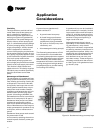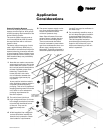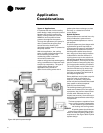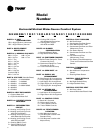
30 WSHP-PRC001-EN
Types of Applications
In systems that use a boiler/cooling
tower design, water pumps are placed
between the auxiliary equipment
(boiler, cooling tower, etc.) and the
WSHPs to ensure positive water
pressure throughout the system.
Through this placement, the pump is
able to pressurize the piping that
serves the units, allowing the
regulated makeup water to pressurize
the pump section.
With this application, the cooling
tower is used to dissipate heat from
the condensing process. The
condensing water is cooled for
recirculation back to the
water-to-refrigerant heat exchanger by
using a combination of heat and mass
transfer by evaporation. The type of
cooling tower chosen for the
application may include an
open-circuit cooling tower with a
gasket-plate heat exchanger to close
the loop, or a closed-circuit fluid
cooler design.
Hybrid Systems
Some systems have evolved into a hy-
brid (combination) system due to
building additions/phases or new re-
quirements.
A hybrid system may have began with
a geothermal ground loop heat ex-
changer used to extract or add heat to
the building. As additional rooms or
buildings were added onto the sys-
tem, the ground loop design became
undersized for the new demand. A
cooling tower may be the solution to
off-load the peak demand of the new
building addition. This may be an inex-
pensive means of tempering the loop
to it’s appropriate working conditions.
The cooling tower may be used in con-
junction with the loop to lower loop
temperatures during off-peak hours
(at night) to support the peak load of
the loop during the day.
Other additions may include a require-
ment for fresh-air ventilation. A
fresh-air, air handler, along with a
chiller may be introduced to the closed
loop system to allow tempered
fresh-air into the building.
The buildings heating and cooling
needs are not based off of one type of
component, but perform harmonious
of each other. Because the loop is
closed, heat recovery from the loop it-
self can be shared with the other major
components.
The heat pumps are capable of heat-
ing or cooling a space independent
of one another to provide individ-
ual heating and cooling needs.
A hybrid system should be con-
sidered on existing building design
when an offset of cooling energy is a
requirement. See Figure 38 for hybrid
system design.
Application
Considerations
Figure 38: Hybrid system design


















